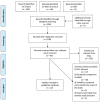Are Modern Head-Mounted Displays Sexist? A Systematic Review on Gender Differences in HMD-Mediated Virtual Reality
- PMID: 32903791
- PMCID: PMC7438857
- DOI: 10.3389/fpsyg.2020.01604
Are Modern Head-Mounted Displays Sexist? A Systematic Review on Gender Differences in HMD-Mediated Virtual Reality
Abstract
Modern head-mounted displays (HMDs) are a promising technology. Thanks to their affordable cost and versatility, HMDs are gaining attention from different sectors. However, the experience reported by the users of these technologies is sometimes negative. A number of people, when using an HMD, complain of various types of physical discomfort as well as symptoms like headache, disorientation, and nausea. These symptoms, developed during or after exposure to virtual environments, are commonly referred to with the term simulator sickness. Some scientific studies have shown that women are commonly more sensitive to simulator sickness. However, a gender imbalance in the susceptibility to simulator sickness has not been widely studied in the context of modern HMDs, and the studies that have been done have reported heterogeneous findings. The present systematic review aims to gather the pieces of evidence that support and oppose a gender difference in the susceptibility of simulator sickness in the framework of modern HMDs. We also aim to individuate other gender differences in the experience of the use of these technologies to establish whether there is sufficient evidence to support a gender discrepancy in the user experience.
Keywords: cyber sickness; gender; sex; simulator sickness; virtual reality.
Copyright © 2020 Grassini and Laumann.
Figures


References
-
- Al Zayer M., Adhanom I. B., MacNeilage P., Folmer E. (2019). The effect of field-of-view restriction on sex bias in VR sickness and spatial navigation performance, in Proceedings of the 2019 CHI Conference on Human Factors in Computing Systems (Glasgow: ). 1–12. 10.1145/3290605.3300584 - DOI
-
- Allen B., Hanley T., Rokers B., Green C. S. (2016). Visual 3D motion acuity predicts discomfort in 3D stereoscopic environments. Entertain. Comput. 13, 1–9. 10.1016/j.entcom.2016.01.001 - DOI
-
- An B., Matteo F., Epstein M., Brown D. E. (2018). Comparing the performance of an immersive virtual reality and traditional desktop cultural game, in Proceedings of the 2nd International Conference on Computer-Human Interaction Research and Applications Vol. 1. CHIRA. 54–61. 10.5220/0006922800540061 - DOI
-
- ArviVR (2018). What do we need to know about HMD. Available online at: https://vr.arvilab.com/blog/hmd-visual-features (accessed February 25, 2020).
Publication types
LinkOut - more resources
Full Text Sources

